Predicting Runoff from the Weigan River under Climate Change
Abstract
1. Introduction
2. Data Sources and Methods
2.1. Overview of the Study Area
2.2. Data Sources
2.3. Research Methodology
2.3.1. Delta Change Method
2.3.2. r-Multi-Model Ensemble
2.3.3. Building A SWAT Hydrological Model
2.3.4. Slope Change Ratio of Accumulative Quantity
3. Results
3.1. Evaluation of Temperature and Precipitation Simulation Capability and Future Prediction
3.1.1. Temperature
3.1.2. Precipitation
3.2. Evaluation of Model Simulation Results
3.3. Prediction and Analysis of Future Runoff Evolution Trends
4. Discussion
4.1. Evaluation of Models’ Simulation Capability
4.2. Model Applicability and Prediction Results
4.3. Shortcomings of This Study
5. Conclusions
Author Contributions
Funding
Institutional Review Board Statement
Informed Consent Statement
Data Availability Statement
Acknowledgments
Conflicts of Interest
References
- Zhou, B.; Qian, J. Changes of weather and climate extremes in the IPCC AR6. Clim. Chang. Res. 2021, 17, 713–718. [Google Scholar] [CrossRef]
- Contractor, S.; Donat, M.G.; Alexander, L.V. Changes in Observed Daily Precipitation over Global Land Areas since 1950. J. Clim. 2021, 34, 3–19. [Google Scholar] [CrossRef]
- Goswami, B.N.; Venugopal, V.; Sengupta, D.; Madhusoodanan, M.S.; Xavier, P.K. Increasing trend of extreme rain events over India in a warming environment. Science 2006, 314, 1442–1445. [Google Scholar] [CrossRef] [PubMed]
- Zhang, W.; Zhou, T. Significant Increases in Extreme Precipitation and the Associations with Global Warming over the Global Land Monsoon Regions. J. Clim. 2019, 32, 8465–8488. [Google Scholar] [CrossRef]
- Huang, L.; Wang, C.; Chao, Q. Interpretation of IPCC special report on climate change and land. Clim. Chang. Res. 2020, 16, 1–8. [Google Scholar] [CrossRef]
- Fan, X.; Qin, Y.; Gao, X. Interpretation of the Main Conclusions and Suggestions of IPCC AR6 Working Group I Report. Environ. Prot. 2021, 49, 44–48. [Google Scholar] [CrossRef]
- Piao, J.; Chen, W.; Wang, L.; Chen, S. Future projections of precipitation, surface temperatures and drought events over the monsoon transitional zone in China from bias-corrected CMIP6 models. Int. J. Climatol. 2022, 42, 1203–1219. [Google Scholar] [CrossRef]
- Zhu, X.; Lee, S.-Y.; Wen, X.; Ji, Z.; Lin, L.; Wei, Z.; Zheng, Z.; Xu, D.; Dong, W. Extreme climate changes over three major river basins in China as seen in CMIP5 and CMIP6. Clim. Dyn. 2021, 57, 1187–1205. [Google Scholar] [CrossRef]
- Ferreira, G.W.d.S.; Reboita, M.S.; Ribeiro, J.G.M.; Souza, C.A.d. Assessment of Precipitation and Hydrological Droughts in South America through Statistically Downscaled CMIP6 Projections. Climate 2023, 11, 166. [Google Scholar] [CrossRef]
- Velázquez, M.A.; Martínez, M.J.M. Historical and Projected Trends of the Mean Surface Temperature in South-Southeast Mexico Using ERA5 and CMIP6. Climate 2023, 11, 111. [Google Scholar] [CrossRef]
- Guo, J.; Shen, Y.; Wang, X.; Liang, X.; Liu, Z.; Liu, L. Evaluation and projection of precipitation extremes under 1.5 °C and 2.0 °C GWLs over China using bias-corrected CMIP6 models. iScience 2023, 26, 106179. [Google Scholar] [CrossRef] [PubMed]
- Xiang, J.; Zhang, L.; Deng, Y.; She, D.; Zhang, Q. Projection and evaluation of extreme temperature and precipitation in major regions of China by CMIP6 models. Eng. J. Wuhan Univ. 2021, 54, 46–57 + 81. [Google Scholar] [CrossRef]
- Hu, Y.; Xu, Y.; Li, J.; Han, Z. Evaluation on the performance of CMIP6 global climate models with different horizontal resolution in simulating the precipitation over China. Clim. Chang. Res. 2021, 17, 730–743. [Google Scholar] [CrossRef]
- Kang, W.; Ni, F.; Deng, Y.; Xiang, J. Response of blue and green water to climate and land use changes: A study in the Wujiang River Basin, China. Trans. Chin. Soc. Agric. Eng. 2023, 39, 131–140. [Google Scholar] [CrossRef]
- Zhao, J.; He, S.; Wang, H. Historical and future runoff changes in the Yangtze River Basin from CMIP6 models constrained by a weighting strategy. Environ. Res. Lett. 2022, 17, 024015. [Google Scholar] [CrossRef]
- Dai, J.; Hu, H.; Mao, X.; Zhang, J. Future climate change trends in the Shiyang River Basin based on the CMIP6 multimodel estimation data. Arid. Zone Res. 2023, 40, 1547–1562. [Google Scholar] [CrossRef]
- He, C.; Luo, C.; Chen, F.; Long, A.; Tang, H. CMIP6 multi-model prediction of future climate change in the Hotan River Basin. Earth Sci. Front. 2023, 30, 515–528. [Google Scholar] [CrossRef]
- Zhang, X.; Wang, X.; Hua, L.; Jiang, D. Projections of Temperature and Precipitation over Xinjiang Based on CMIP6 Model. Chin. J. Atmos. Sci. 2023, 47, 387–398. [Google Scholar] [CrossRef]
- Li, F.; Zhang, G.; Dong, L. Studies for Impact of Climate Change on Hydrology and Water Resources. Sci. Geogr. Sin. 2013, 33, 457–464. [Google Scholar] [CrossRef]
- FAO. The State of the World’s Land and Water Resources for Food and Agriculture—Systems at Breaking Point; Synthesis Report 2021; ResearchGate: Rome, Italy, 2021; p. 58. [Google Scholar]
- Su, J.; Long, A.; Chen, F.; Ren, C.; Zhang, P.; Zhang, J.; Gu, X.; Deng, X. Impact of the Construction of Water Conservation Projects on Runoff from the Weigan River. Water 2023, 15, 2431. [Google Scholar] [CrossRef]
- Yang, C. Dynamic Change and Prediction Research of Land Use in Baicheng County. Master’s Thesis, Xinjiang University, Ürümqi, China, 2018. [Google Scholar]
- Xu, J.; Hu, Y.; Li, J.; Zhu, B.; Ren, N. Assessment of long-term variations of wind speed and wind resources in china seas under the global warming. Adv. Mar. Sci. 2023, 42, 1–12. [Google Scholar] [CrossRef]
- Liu, J.; Tang, H.; Yan, F.; Liu, S.; Tang, X.; Ding, Z.; Yu, P. Future variation of land surface temperature in the Yangtze River Basin based on CMIP6 model. Int. J. Digit. Earth 2023, 16, 2776–2796. [Google Scholar] [CrossRef]
- Peng, S.; Ding, Y.; Wen, Z.; Chen, Y.; Cao, Y.; Ren, J. Spatiotemporal change and trend analysis of potential evapotranspiration over the Loess Plateau of China during 2011–2100. Agric. For. Meteorol. 2017, 233, 183–194. [Google Scholar] [CrossRef]
- Zhang, X.; Hua, L.; Jiang, D. Assessment of CMIP6 model performance for temperature and precipitation in Xinjiang, China. Atmos. Ocean. Sci. Lett. 2022, 15, 41–48. [Google Scholar] [CrossRef]
- Lou, H. Analysis of Water Resource Availability in Yanghe River Basin Basedon SWATmodel. Master’s Thesis, Hubei University of Technology, Wuhan, China, 2020. [Google Scholar]
- Zhao, A.; Liu, X.; Zhu, X.; Pan, Y.; Li, Y. Spatiotemporal patterns of droughts based on SWAT model for the Weihe River Basin. Prog. Geogr. 2015, 34, 1156–1166. [Google Scholar] [CrossRef][Green Version]
- Wang, S.; Yan, Y.; Yan, M.; Zhao, X. Contributions of Precipitation and Human Activities to the Runoff Change of the Huangfuchuan Drainage Basin: Application of Comparative Method of the Slope Changing Ratio of Cumulative Quantity. Acta Geogr. Sin. 2012, 67, 388–397. [Google Scholar] [CrossRef]
- Chen, F.; Wang, Y.; Wu, Z.; Feng, P. Impacts of Climate Change and Human Activities on Runoff of Continental River in Arid Areas. Arid. Zone Res. 2015, 32, 692–697. [Google Scholar] [CrossRef]
- Zheng, J.; Yan, Z.; Li, D.; Zhou, Z.; Zhang, X.; Liu, J. Spatio-temporal evolution of the rainfall—Runoff relationship in the Yellow River Basin. J. Water Resour. Water Eng. 2021, 32, 77–85 + 92. [Google Scholar] [CrossRef]
- Helali, J.; Oskouei, E.A.; Hosseini, S.A.; Saeidi, V.; Modirian, R. Projection of changes in late spring frost based on CMIP6 models and SSP scenarios over cold regions of Iran. Theor. Appl. Climatol. 2022, 149, 1405–1418. [Google Scholar] [CrossRef]
- Zhang, J.; Lun, Y.; Liu, L.; Liu, Y.; Li, X.; Xu, Z. CMIP6 evaluation and projection of climate change in Tibetan Plateau. J. Beijing Norm. Univ. (Nat. Sci.) 2022, 58, 77–89. [Google Scholar] [CrossRef]
- Zhang, J. Sea Level Change in Coastal China Seas during the 21st Based on SSPs Scenarios. Master’s Thesis, Zhejiang Ocean University, Zhoushan, China, 2022. [Google Scholar]
- Firpo, M.Â.F.; Guimarães, B.d.S.; Dantas, L.G.; Silva, M.G.B.d.; Alves, L.M.; Chadwick, R.; Llopart, M.P.; Oliveira, G.S.d. Assessment of CMIP6 models’ performance in simulating present-day climate in Brazil. Front. Clim. 2022, 4, 948499. [Google Scholar] [CrossRef]
- He, X.; Jiang, C.; Wang, J.; Wang, X. Comparison of CMIP6 and CMIP5 models performance in simulating temperature in Northeast China. Chin. J. Geophys. 2022, 65, 4194–4207. [Google Scholar] [CrossRef]
- Wu, C. Assessment and Cause Analysis of Extreme Climate Change in the Upper and Middle Reaches of Huai River Basin Based on CMIP6. Master’s Thesis, Yangzhou University, Yangzhou, China, 2023. [Google Scholar]
- Yasin, G.; Zhang, J.; Zhao, T. CMIP6 Model-Projected Future Changes in Extreme Precipitation over Central Asia in the 21st Century. Clim. Environ. Res. 2023, 28, 286–302. [Google Scholar] [CrossRef]
- Ali, Z.; Hamed, M.M.; Muhammad, M.K.I.; Iqbal, Z.; Shahid, S. Performance evaluation of CMIP6 GCMs for the projections of precipitation extremes in Pakistan. Clim. Dyn. 2023, 61, 4717–4732. [Google Scholar] [CrossRef]
- Yazdandoost, F.; Moradian, S.; Izadi, A.; Aghakouchak, A. Evaluation of CMIP6 precipitation simulations across different climatic zones: Uncertainty and model intercomparison. Atmos. Res. 2021, 250, 105369. [Google Scholar] [CrossRef]
- Sime, C.H.; Dibaba, W.T. Evaluation of CMIP6 model performance and extreme precipitation prediction in the Awash basin. Heliyon 2023, 9, e21578. [Google Scholar] [CrossRef] [PubMed]
- Chen, C. Analysis of Water Resources Evolution and Vulnerability Assessment under Climate Change in the Chushandian Reservoir Basin. Master’s Thesis, Zhengzhou University, Zhengzhou, China, 2022. [Google Scholar]
- Liu, Q. Study on the Evolution Mechanisms of Water Resources in Taoer River Basin under the Changing Environment. Master’s Thesis, Dalian University of Technology, Dalian, China, 2020. [Google Scholar]
- Zhang, D.; Liang, H.; He, X.; Shi, Y. Projections of runoff and hydrological drought in the Jinsha River Basin based on CMIP6. Water Resour. Prot. 2023, 39, 53–62. [Google Scholar] [CrossRef]
- Liu, Q. Downscaling of Temperature and Precipitation in the Daling River Basin, Liaoning Province. Master’s Thesis, Fujian Normal University, Fuzhou, China, 2022. [Google Scholar]
- Ni, M.; Duan, Z.; Xia, J. Melting of mountain glacier and its risk to future water resources in Southern Xinjiang, China. Mt. Res. 2022, 40, 329–342. [Google Scholar] [CrossRef]
- Shi, Y.; Shen, Y.; Li, D.; Zhang, G.; Ding, Y.; Hu, R.; Kang, E. Discussion on The Present Climate Change From Warm-dry to Warm-wet in Northwest China. Quat. Sci. 2003, 23, 152–164. [Google Scholar] [CrossRef]
- Hua, L.; Zhao, T.; Zhong, L. Future changes in drought over Central Asia under CMIP6 forcing scenarios. J. Hydrol. Reg. Stud. 2022, 43, 101191. [Google Scholar] [CrossRef]
- Wang, C.; Zhang, S.; Zhang, F.; Li, K.; Yang, K. On the increase of precipitation in the Northwestern China under the global warming. Adv. Earth Sci. 2021, 36, 980–989. [Google Scholar] [CrossRef]
- Yan, D.; Werners, S.E.; Ludwig, F.; Huang, H.Q. Hydrological response to climate change: The Pearl River, China under different RCP scenarios. J. Hydrol. Reg. Stud. 2015, 4, 228–245. [Google Scholar] [CrossRef]
- Wu, J.; Ju, Q.; Liu, X.; Lian, Z.; Zhang, Y.; Duan, Y. Assessment of precipitation and temperature in the water conservation region of the Yellow River Basin using CMIP6 models. Hydro-Sci. Eng. 2023, 6, 1–14. [Google Scholar] [CrossRef]
- Huang, P.; Ying, J. A Multimodel Ensemble Pattern Regression Method to Correct the Tropical Pacific SST Change Patterns under Global Warming. J. Clim. 2015, 28, 4706–4723. [Google Scholar] [CrossRef]
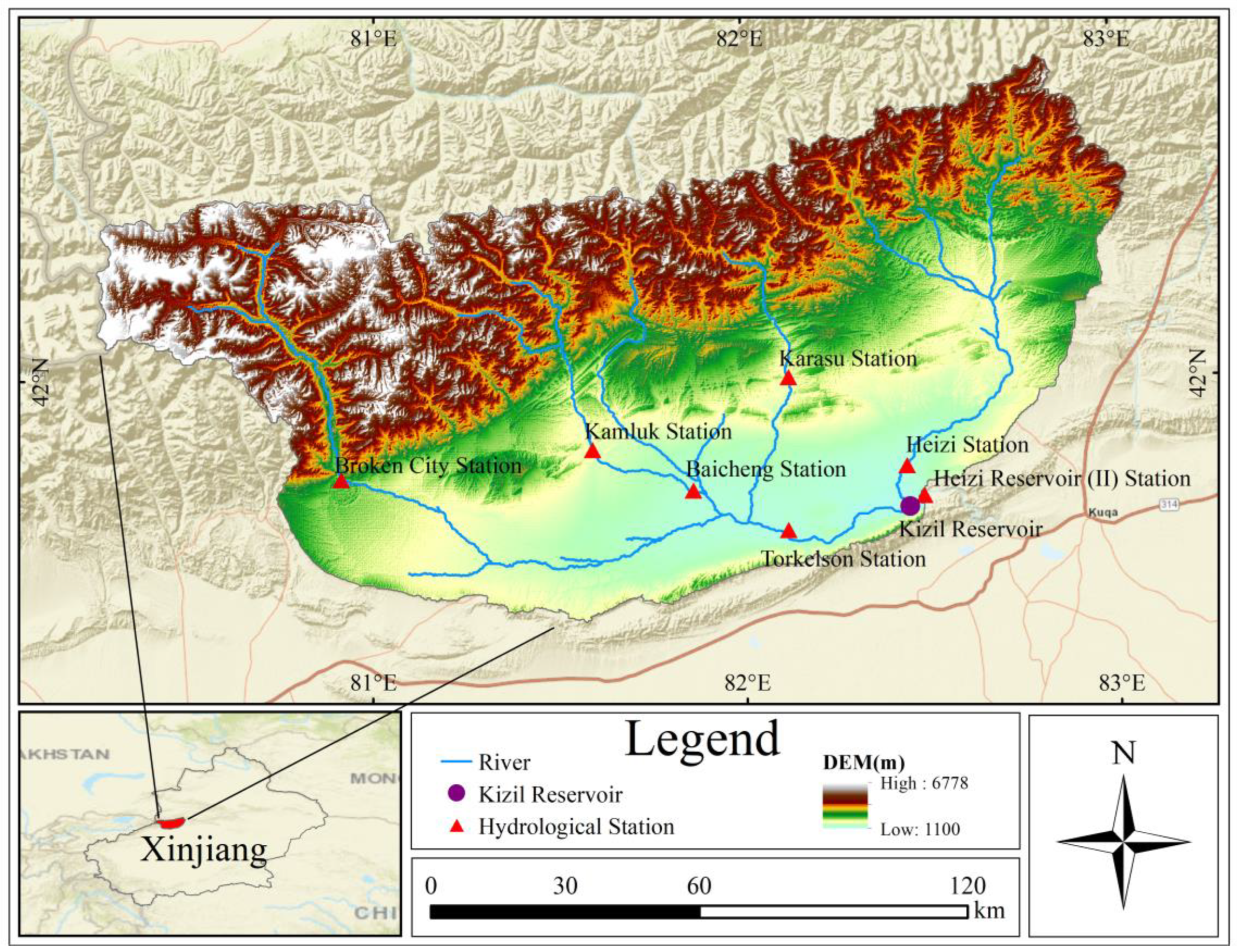
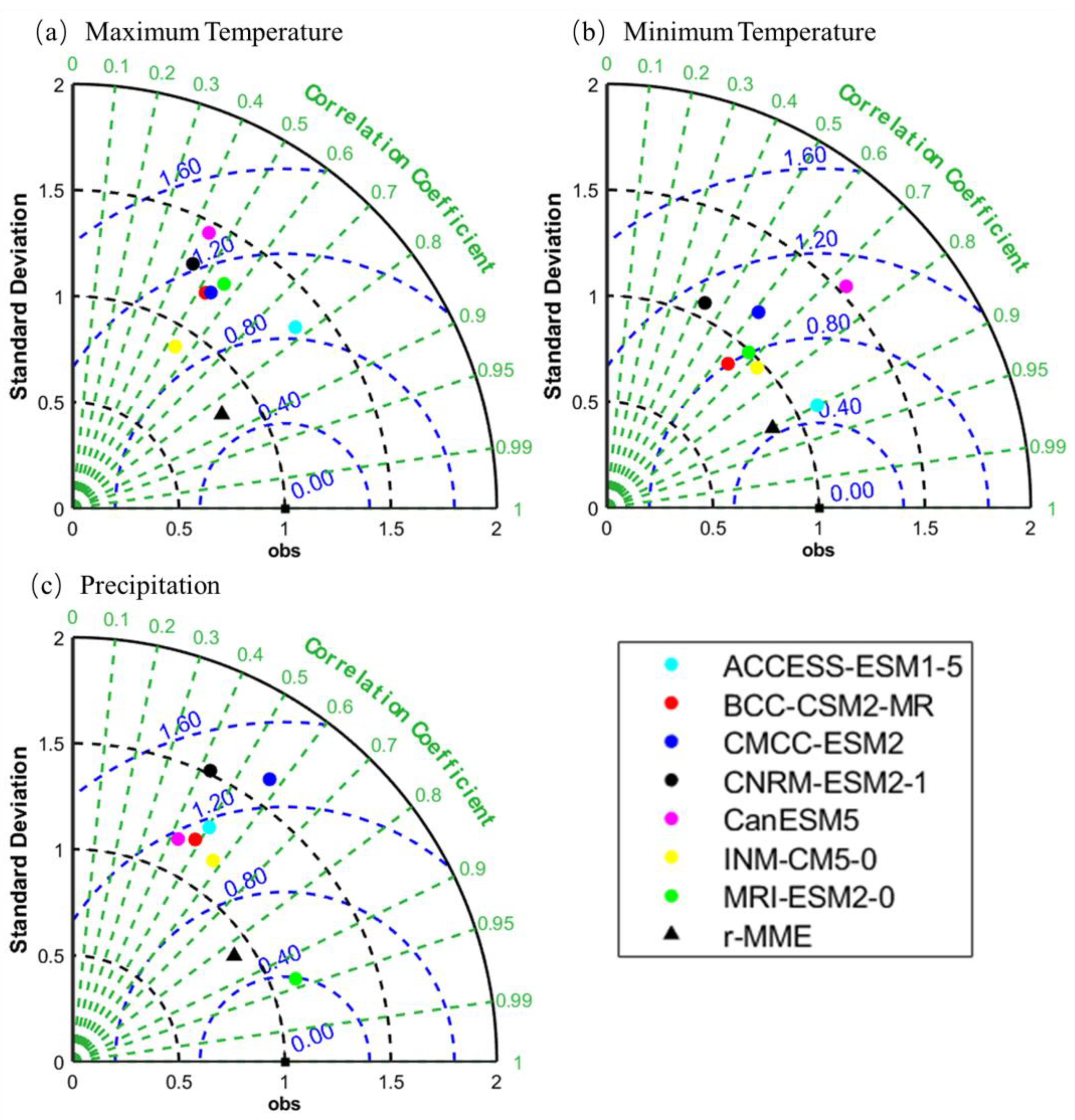
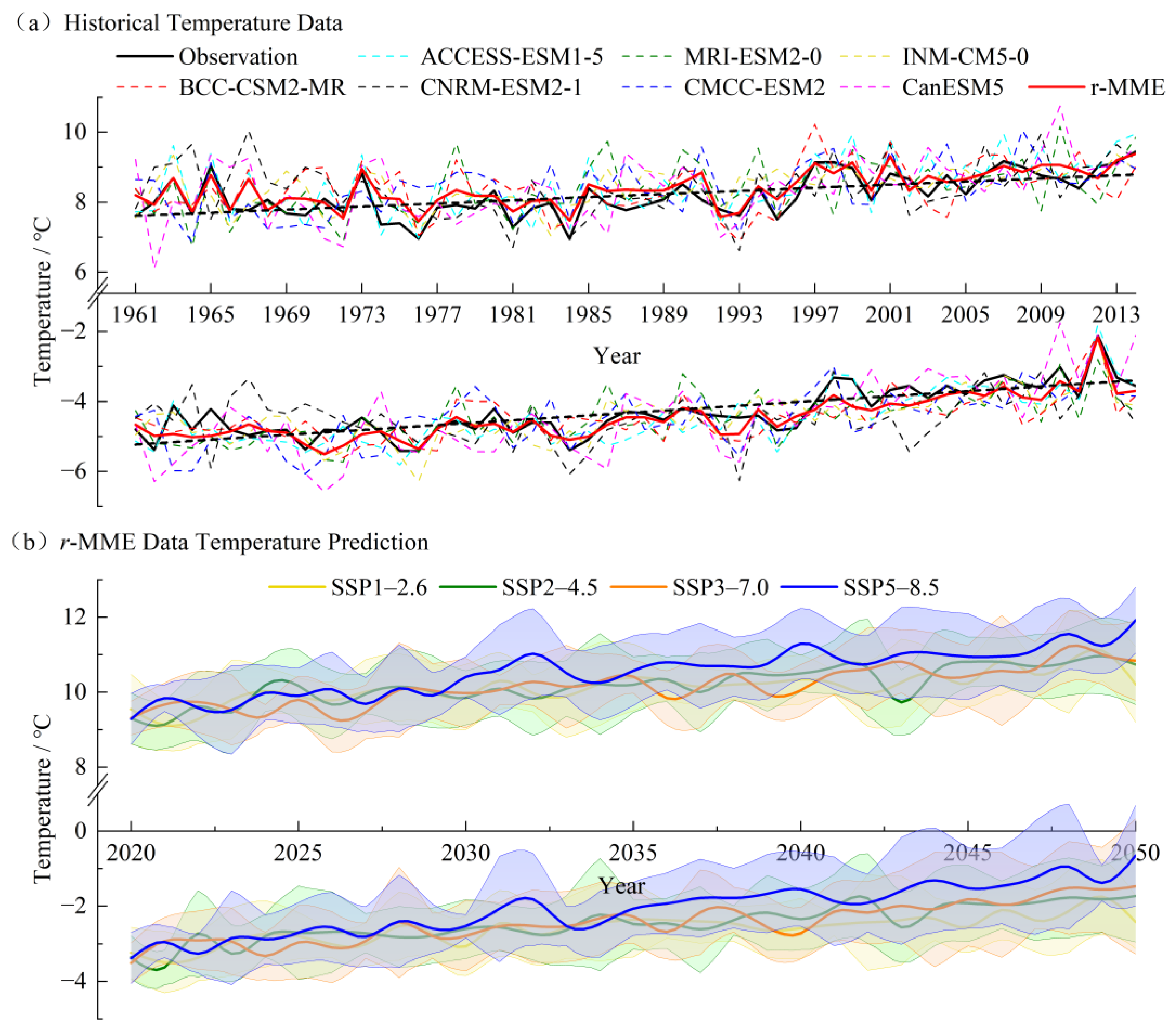
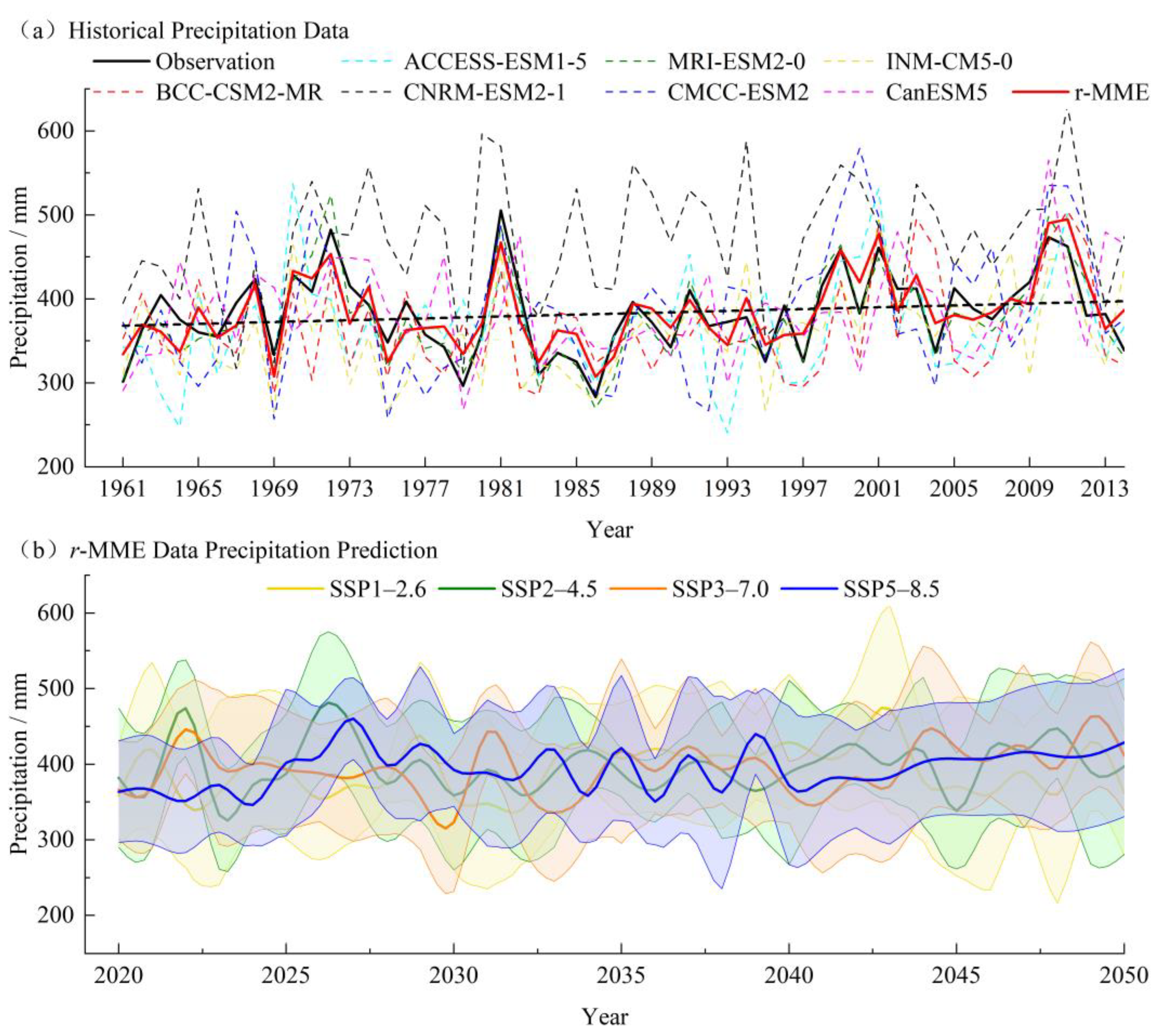
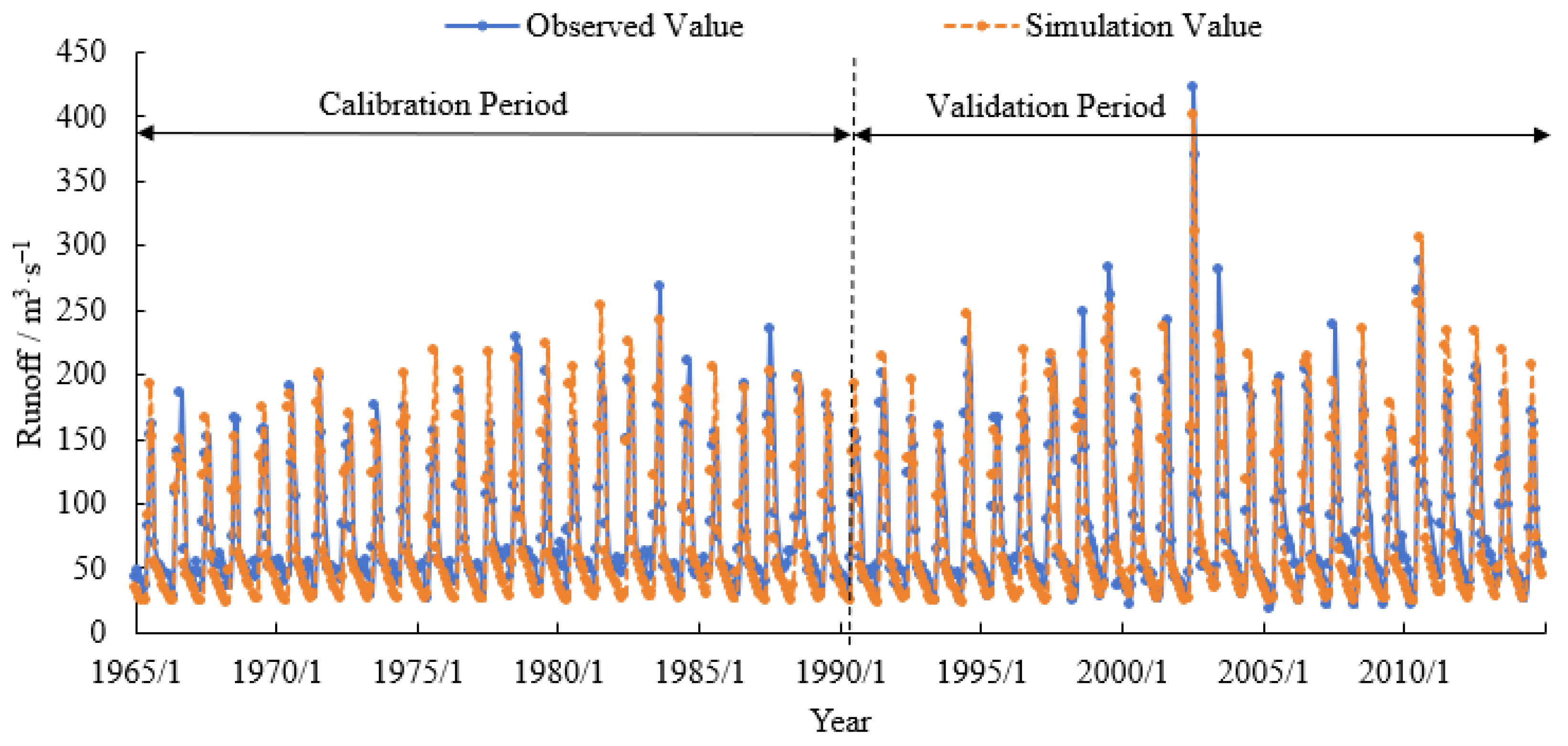
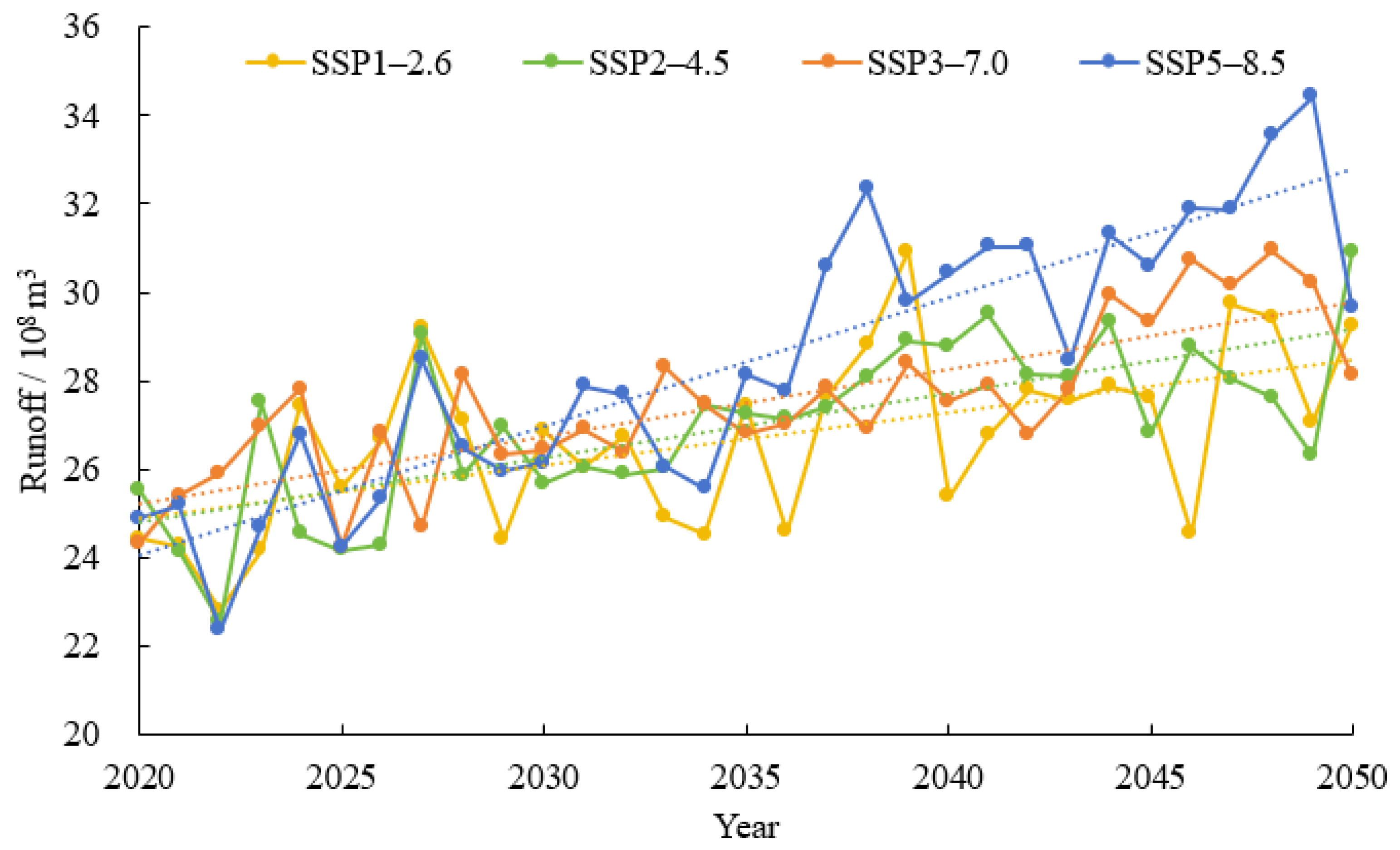
| Number | Pattern Name | Research Institutions | Source Country | Original Resolution |
|---|---|---|---|---|
| 1 | ACCESS-ESM1-5 | Australian Community Climate and Earth System Simulator | Australia | 1.88 × 1.25 |
| 2 | BCC-CSM2-MR | National Climate Centre | China | 2.88 × 1.92 |
| 3 | CanESM5 | Canadian Centre for Climate Modelling and Analysis | Canada | 2.8 × 2.8 |
| 4 | CMCC-ESM2 | Centro Euro-Mediterraneo sui Cambiamenti Climatici | Italy | 1.25 × 1.0 |
| 5 | CNRM-ESM2-1 | National Center for Meteorological Research | France | 1.41 × 1.39 |
| 6 | INM-CM4-8 | Marchuk Institute of Numerical Mathematics | Russia | 2.0 × 1.5 |
| 7 | MRI-ESM2-0 | Meteorological Research Institute | Japan | 1.1 × 1.1 |
| Time Period | Actual Runoff/108 m3 a−1 | Simulate Runoff/108 m3 a−1 | NSE | RSR | PBIAS/% | R2 | Simulation Results |
|---|---|---|---|---|---|---|---|
| Calibration Period (1 January 1965–31 December 1989) | 24.19 | 22.77 | 0.75 | 0.50 | 5.91 | 0.82 | Good |
| Validation Period (1 January 1990–31 December 2014) | 26.70 | 24.84 | 0.83 | 0.41 | 6.98 | 0.86 | Good |
| Whole Period (1 January 1965–31 December 2014) | 25.47 | 23.82 | 0.80 | 0.45 | 6.47 | 0.84 | Good |
| Time Period | SSP1–2.6 | SSP2–4.5 | SSP3–7.0 | SSP5–8.5 | ||||
|---|---|---|---|---|---|---|---|---|
| Runoff/m3·s−1 | Rate/% | Runoff/m3·s−1 | Rate/% | Runoff/m3·s−1 | Rate/% | Runoff/m3·s−1 | Rate/% | |
| 1965–2014 | 80.63 | - | 80.63 | - | 80.63 | - | 80.63 | - |
| 2021–2030 | 81.92 | 1.61% | 80.73 | 0.12% | 83.25 | 3.26% | 81.03 | 0.50% |
| 2031–2040 | 84.58 | 4.90% | 86.48 | 7.26% | 86.65 | 7.48% | 90.69 | 12.48% |
| 2041–2050 | 87.98 | 9.12% | 89.83 | 11.42% | 92.52 | 14.75% | 99.44 | 23.34% |
Disclaimer/Publisher’s Note: The statements, opinions and data contained in all publications are solely those of the individual author(s) and contributor(s) and not of MDPI and/or the editor(s). MDPI and/or the editor(s) disclaim responsibility for any injury to people or property resulting from any ideas, methods, instructions or products referred to in the content. |
© 2024 by the authors. Licensee MDPI, Basel, Switzerland. This article is an open access article distributed under the terms and conditions of the Creative Commons Attribution (CC BY) license (https://creativecommons.org/licenses/by/4.0/).
Share and Cite
Su, J.; Zhang, P.; Deng, X.; Ren, C.; Zhang, J.; Chen, F.; Long, A. Predicting Runoff from the Weigan River under Climate Change. Appl. Sci. 2024, 14, 541. https://doi.org/10.3390/app14020541
Su J, Zhang P, Deng X, Ren C, Zhang J, Chen F, Long A. Predicting Runoff from the Weigan River under Climate Change. Applied Sciences. 2024; 14(2):541. https://doi.org/10.3390/app14020541
Chicago/Turabian StyleSu, Jingwen, Pei Zhang, Xiaoya Deng, Cai Ren, Ji Zhang, Fulong Chen, and Aihua Long. 2024. "Predicting Runoff from the Weigan River under Climate Change" Applied Sciences 14, no. 2: 541. https://doi.org/10.3390/app14020541
APA StyleSu, J., Zhang, P., Deng, X., Ren, C., Zhang, J., Chen, F., & Long, A. (2024). Predicting Runoff from the Weigan River under Climate Change. Applied Sciences, 14(2), 541. https://doi.org/10.3390/app14020541







